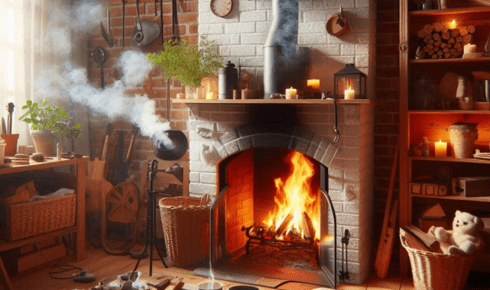A fireplace is one of the coziest features a home can have. Whether it’s the crackle of wood logs or the push-button ease of gas flames, fireplaces offer comfort, warmth, and charm.
But behind the relaxing glow, there’s a chimney working hard—and keeping that chimney safe and clean requires proper maintenance. The question many homeowners ask is:
Do wood-burning and gas fireplaces need different chimney care?
The answer is yes. And understanding those differences can save you money, prevent fire hazards, and help your system last longer. If you’re unsure how to care for your fireplace and chimney, this guide will break it down simply, clearly, and with tips you can act on right away.
Understanding How Each System Works
Before we dive into maintenance needs, let’s look at how each type of fireplace functions.
Wood-Burning Fireplaces
Wood-burning fireplaces rely on combustion. You light real wood, it burns, and the smoke rises through your chimney and out into the air. The process is natural, but it’s not clean. Burning wood produces ash, creosote (a sticky, flammable residue), and a lot of smoke.
This type of fireplace provides that traditional, nostalgic experience—with the smell of burning wood and the warmth of a real flame. But with that ambiance comes a greater need for hands-on cleaning and chimney care.
Gas Fireplaces
Gas fireplaces operate with clean-burning natural gas or propane. They don’t produce ash or creosote in the same way wood does. Many gas units are vented through traditional chimneys, while others use direct vent systems or even no chimney at all.
Gas fireplaces offer convenience, cleaner combustion, and lower maintenance overall. However, that doesn’t mean they’re maintenance-free.
Chimney Maintenance for Wood-Burning Fireplaces
Wood-burning fireplaces require regular and thorough maintenance. If left neglected, creosote buildup becomes dangerous—it’s highly flammable and a major cause of chimney fires.
Top Maintenance Needs:
- Annual Chimney Sweeping
Every year (or after burning about a cord of wood), have your chimney professionally cleaned. This removes creosote, soot, and blockages like leaves or animal nests. - Creosote Monitoring
If you notice a strong, tar-like smell or black flakes inside the firebox, you likely have a creosote problem. Don’t wait—it’s a serious fire hazard. - Chimney Inspections
Have your chimney inspected yearly by certified professionals. They’ll check for cracks, blockages, liner damage, and leaks that could compromise safety. - Firebox Cleaning
Clear out ash regularly, but leave about an inch to help insulate the next fire. - Burn Seasoned Hardwood
Wet or soft woods cause more creosote buildup. Always use seasoned, dry hardwood for cleaner burns.
Chimney maintenance isn’t just a safety measure—it ensures better airflow, less smoke backdraft, and more efficient heat output.
Chimney Maintenance for Gas Fireplaces
Gas fireplaces are often marketed as “low maintenance,” and while that’s partially true, they still need attention. The biggest risk with gas fireplaces isn’t creosote—it’s carbon monoxide, gas leaks, and blocked vents.
Key Maintenance Tasks:
- Annual Inspection
A gas fireplace should be inspected every year to check the burners, valves, pilot light, gas lines, and venting system. Small issues can quickly become major hazards. - Check the Chimney or Vent
If your gas fireplace vents through a chimney, it still needs to be inspected. Birds and debris can block the flue, and internal corrosion can go unnoticed without a professional look. - Carbon Monoxide Detectors
Because gas combustion produces carbon monoxide, every home with a gas fireplace should have a working detector nearby. - Glass Cleaning and Gasket Check
The glass window can build up residue and needs gentle cleaning. Inspect the gasket seal around the door to ensure no gas escapes. - Pilot Light Maintenance
If your pilot light frequently goes out or is hard to start, it could signal a bigger issue.
Even if you’re not burning logs, gas systems need trained eyes to catch hidden problems before they become dangerous.
Comparing the Two: At a Glance
Maintenance Task
Wood-Burning Fireplace
Gas Fireplace
Chimney sweeping
Every 1-2 years or after heavy use
Every 2-3 years if vented through flue
Inspection
Annually
Annually
Creosote buildup
High risk
Minimal to none
Fire hazard
High if not cleaned
Low, but possible with vent blockage
Carbon monoxide risk
Low
Moderate if venting fails
Cost of maintenance
Moderate to high
Low to moderate
DIY cleaning
Some parts (ash, glass)
Some parts (glass, exterior)
Common Misconceptions That Can Lead to Costly Mistakes“Gas fireplaces don’t need chimney maintenance.”
False. If your gas fireplace vents through a chimney, you still need to check for blockages, cracks, and leaks. Even non-vented units need the gas lines and combustion system checked regularly.
“I only use my fireplace a few times a year, so it’s fine.”
Infrequent use doesn’t mean it’s clean or safe. Even small fires can create creosote, and critters can block your flue any time of year.
“I can clean the chimney myself.”
DIY chimney cleaning is not only ineffective—it’s dangerous. Professionals use special equipment, safety gear, and training to do a thorough job. Trust the pros.
So, Which Fireplace Is Easier to Maintain?
If ease of maintenance is your top concern, gas fireplaces win. They produce less mess, fewer pollutants, and less risk of fire from buildup. But that doesn’t mean you can ignore them.
Wood-burning fireplaces require more hands-on care, but for many homeowners, the authentic experience is worth it. As long as you’re consistent with maintenance, both types can provide years of safe, reliable warmth.
The key is knowing what your system needs—and staying on top of it.
Let the Pros Keep Your Fireplace Safe and Efficient
Whether you have a traditional wood-burning hearth or a sleek modern gas fireplace, professional chimney maintenance is essential to keep your home safe and your system running smoothly.
At www.reliantchimneysweeps.com, we provide expert inspections, cleanings, and repairs for all types of fireplaces. Our team understands the unique needs of both wood and gas systems and will help you enjoy your fireplace with confidence, comfort, and peace of mind.
Don’t wait for a problem to show up—schedule your chimney inspection or cleaning today and keep your home safe, warm, and worry-free.

